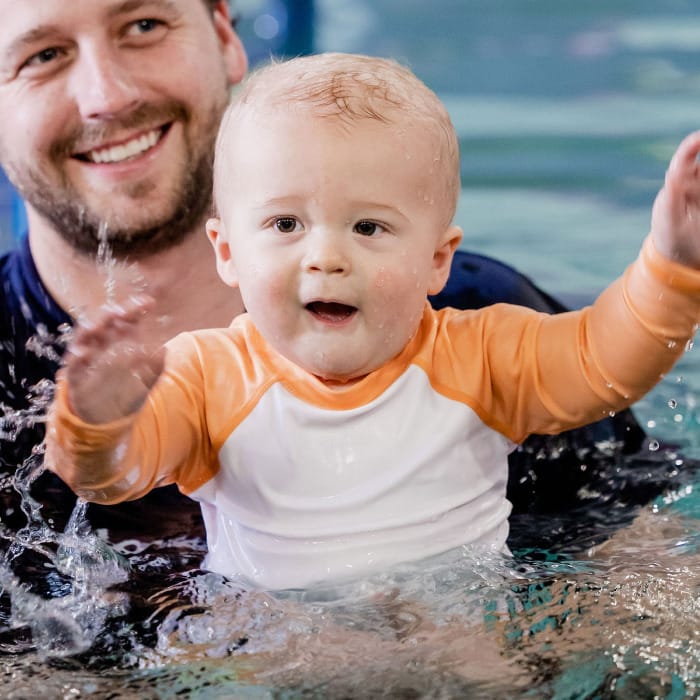Ten Water Safety Tips for Families on Vacation
Jun 17, 2024
Getting ready for your upcoming summer vacation? Keep your family safer around the water with these ten tips!
Your luggage may be packed and your hotel may be booked, but has your family finalized a vacation water-safety plan? If any water activities are on the docket for your trip, you’ll want to keep one handy; accidents can happen to anyone, and drowning is still the leading cause of unintentional death for children aged 1-4.
We’ve compiled our top ten tips for building a water safety plan– these tips are applicable whether you are going to a beach, a lake, or a pool.
These tips are not ranked in any order– they are meant to build upon each other. Preparation is the first step to staying safer in and around the water!
Build a Water-Safety Plan with These 10 Helpful Guidelines
1. Set Clear Expectations Before You Leave
We are not tired of the cliche, “communication is key,” because it’s true! Before you leave, ensure the whole family is on the same page regarding behaviors in and around the water.
- Always let kids know it’s not ok to enter into any body of water without an adult with them.
- For adults, establish expectations on child-supervision. Determine who will be taking Water Watcher shifts (keep reading– we’ll have more on Water Watchers later).
2. Evaluate Water Competency
Water Safety USA has defined “water competency” as the ability to “anticipate, avoid, and survive common drowning situations, as well as being able to recognize and provide assistance to those in need.” In short, the three core aspects of water competency are water awareness, swimming skills, and the ability to help others.
Ask Questions for Water Competency Evaluations:
- Water Awareness
- Are you able to identify riptides?
- Do you know which sea animals you may encounter in the water and which ones may sting or bite a swimmer?
- Swimming Skills
- Are you able to safely enter the water and resurface?
- What is the distance that each of your family members can safely swim?
- How does this distance change when you are in a pool vs. a still lake vs. a wavy sea?
- Ability to Help Others
- Are your family members able to identify signs of a drowning person?
- Ensure your children know how to seek help in case of an emergency. For example, we teach our students to say, “Help! I need an adult! There’s someone that needs help!” We call this technique “Yell and Go Tell.”
- Who is going to be supervising your family members who cannot safely swim?*
- Do you have your Water Watchers planned out for the day?
- Drowning is fast and silent. Children should never be left unattended in or around the water.
- Are your family members able to identify signs of a drowning person?
*Please ensure that children are always supervised by an adult who is within arms reach, also known as “touch supervision.”
3. Take Swimming Lessons Before Vacation
By taking formal swimming lessons, children ages 1-4 can reduce their drowning risk by 88%. That’s a huge number!
Although it takes more than a few lessons to become an “expert” swimmer, we really do recommend that all family members brush up on their swim skills before vacation.
That is one of the reasons why we offer Emler swim CAMP during the summer! Each lesson lasts 30 minutes, and one may sign up for as many or as few CAMP sessions they are able to attend. Additionally, our instructors would be more than happy to speak with you about any concerns you have regarding water safety while on vacation!
4. Understand the Importance of Water Watchers
A water watcher is a trusted adult who will pay constant attention to children in the water. This means no phones, no alcohol consumption, no distractions. Even if there is a lifeguard on duty, a water watcher is still necessary, especially if a child with lower water competency is in the water. Drowning is silent, so always stay alert.
We recommend sharing the responsibility– water watchers should switch shifts every 10-15 minutes.
Designate A Trustworthy Water Watcher:
- Eliminates all distractions to keep a close watch of children in the water.
- Keeps a whistle or another device to alert others of an emergency (this is especially important because your voice maynot carry across the water).
- Displays exceptional water competency and situational awareness skills to immediately recognize and rescue a swimmer in distress.
- Knows CPR or can alert someone nearby who does.
- Transitions Water Watcher shifts responsibly.
5. Teach Your Family Situational Awareness
Want to know a cliche we do dislike? It’s the cliche of “common sense.”
Situational awareness can be described as the understanding of the environment you’re in, its various components, and the dynamic nature of the environment in response to different stimuli. It’s easy to dismiss situational awareness as “common sense,” but that “sense” may fly out the window when faced with an unexpected situation– especially a drowning incident.
6. Evaluate Bodies of Water
- Is there a lifeguard present? If not, is there an emergency phone, or do you have cell service to make calls?
- Are there tools to use in case of an emergency, such as a buoy or rescue ring?
- How crowded is the beach area? Is there plenty of space where you can see your children at all times, or is the beach crowded with patrons and large umbrellas blocking your view?
- Do you have resources for food, water, sunscreen, and shade?
- While in the water, is everyone wearing their floatation gear properly?
7. Create an Emergency Action Plan (EAP)
You can create an emergency action plan for just about anything! If you don’t already have one, that’s ok. You can think of an emergency action plan as a document that identifies an emergency and designates time-sensitive actions for specific people in your family.
Consider including the following in your family’s vacation emergency action plan:
- Signs of a distressed or drowning person.
- Determination of who has the ability to rescue a distressed or drowning person vs. who has the ability to call for assistance or throw a rescue ring or floating toy.
- Flowchart of drowning rescue techniques.
- Local emergency numbers and hotlines.
- AED locations in your hotel, around pools, or on the beach.
Here is a great example of an Aquatic Emergency Action Plan created by USA Swimming.
8. Get CPR Certified
Administering CPR to an unresponsive* drowned person can significantly increase the chances of survival. When a human’s breathing is inhibited, the body cannot receive adequate oxygen for its vital tissues. This often leads to cardiac arrest.
CPR is a life-saving technique that stimulates blood flow, and therefore, oxygen circulation! Anyone can learn CPR, and we highly recommend at least one family member be CPR-certified before leaving for vacation.
**Never use CPR on someone who has a pulse.**
9. Pack Proper Gear
Not all flotation devices are made equal. Floaties may look cute, but they absolutely do not prevent drowning. Instead, ensure each family member has a Coast Guard-approved life jacket.
If you want to learn more about why you shouldn’t rely on arm floaties, click here to watch a discussion on the various floatation devices that parents use, featuring our lovely Emler Swim School Spring-Klein team!
Other Essential Gear:
- Sunscreen
- Sunhats/Sunglasses
- Extra water
- Energy snacks, such as fresh or dried fruit
10. Never Forget “Touch Supervision"
We’ve mentioned this a couple of times, and it gets its own heading because it’s that important, especially for children with lower water competency. According to the American Academy of Pediatrics, effective touch supervision means the “supervising adult is within arm’s reach of the child so he or she can pull the child out of the water if the child’s head becomes submerged underwater.” This applies to both bath time and swim time.
Drowning can happen silently and instantaneously. If you’re leaving the water and can’t provide touch supervision, take your child with you, even if there is a lifeguard on duty!
Stay Nourished to Stay Alert
How do you feel when you’re “hangry” and dehydrated? Maybe you feel a little irrational, a little impulsive, a little frazzled– all things that are probably not conducive to following your emergency response plan.
The same applies to the little ones; if they’re hungry or thirsty, it will be harder for them to stay focused. Ensure that everyone is taking adequate food and water breaks if you’re going to be on the water all day! A nourished mind is an alert mind.





